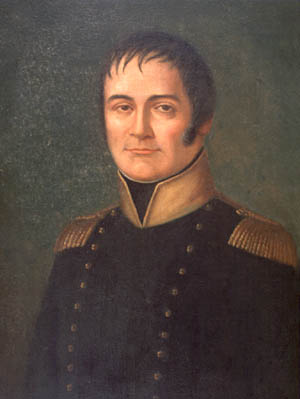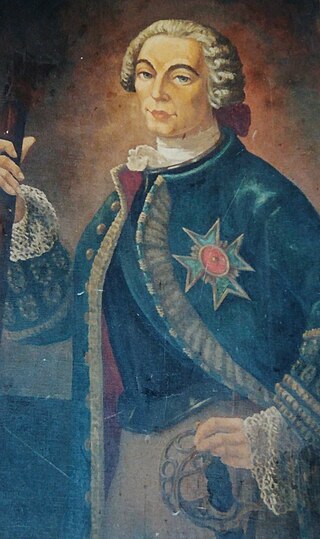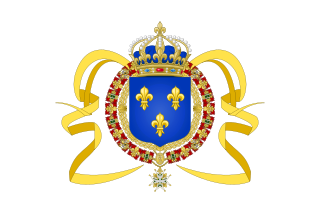
The Louisiana Purchase was the acquisition of the territory of Louisiana by the United States from the French First Republic in 1803. This consisted of most of the land in the Mississippi River's drainage basin west of the river. In return for fifteen million dollars, or approximately eighteen dollars per square mile, the United States nominally acquired a total of 828,000 sq mi in Middle America. However, France only controlled a small fraction of this area, most of which was inhabited by Native Americans; effectively, for the majority of the area, the United States bought the preemptive right to obtain Indian lands by treaty or by conquest, to the exclusion of other colonial powers.

François Barbé-Marbois, marquis de Barbé-Marbois was a French politician.

Jacques Philippe Villeré was the second Governor of Louisiana after it became a state. He was the first Creole and the first native of Louisiana to hold that office.

In the context of the history of slavery in the Americas, free people of color were primarily people of mixed African, European, and Native American descent who were not enslaved. However, the term also applied to people born free who were primarily of black African descent with little mixture. They were a distinct group of free people of color in the French colonies, including Louisiana and in settlements on Caribbean islands, such as Saint-Domingue (Haiti), St. Lucia, Dominica, Guadeloupe, and Martinique. In these territories and major cities, particularly New Orleans, and those cities held by the Spanish, a substantial third class of primarily mixed-race, free people developed. These colonial societies classified mixed-race people in a variety of ways, generally related to visible features and to the proportion of African ancestry. Racial classifications were numerous in Latin America.

Louisiana or French Louisiana was an administrative district of New France. In 1682 the French explorer René-Robert Cavelier, Sieur de la Salle erected a cross near the mouth of the Mississippi River and claimed the whole of the drainage basin of the Mississippi River in the name of King Louis XIV, naming it "Louisiana". This land area stretched from the Great Lakes to the Gulf of Mexico and from the Appalachian Mountains to the Rocky Mountains. The area was under French control from 1682 to 1762 and in part from 1801 (nominally) to 1803.

Charles-Étienne Arthur Gayarré was an American historian, attorney, slaveowner and politician born to a Spanish and French Creole planter family in New Orleans, Louisiana. He was a Confederate sympathizer and white supremacist.

Étienne Perier or Étienne de Perier (1686–1766), also known as Perier the Elder, was a French naval officer and governor of French Louisiana from 1726 to 1733. His time as governor included some notable achievements, including the construction of the first levee along the Mississippi River in 1727. In response to the Natchez Revolt, he attempted to completely destroy the Natchez people, which increased Native American hostility toward the French in the territory. Because he failed to secure the safety of the colony, Perier was recalled as governor in March 1733. He later distinguished himself as a naval officer and privateer, including during the capture of HMS Northumberland in 1744.

Louisiana Creoles are a Louisiana French ethnic group descended from the inhabitants of colonial Louisiana before it became a part of the United States during the period of both French and Spanish rule. They share cultural ties such as the traditional use of the French, Spanish, and Creole languages and predominant practice of Catholicism.

The term Creole music is used to refer to two distinct musical traditions: art songs adapted from 19th-century vernacular music; or the vernacular traditions of Louisiana Creole people which have persisted as 20th- and 21st-century la la and zydeco in addition to influencing Cajun music.
Pierre Lafitte was a pirate in the Gulf of Mexico and smuggler in the early 19th century. He also ran a blacksmith shop in New Orleans, his legitimate business. Pierre was historically less well known than his younger brother, Jean Lafitte. While not as much of a sailor as Jean, Pierre was the public face of the Lafitte operation, and was known for his wit and charm, in addition to his handling of the sale of smuggled goods.
Jeanne-Marie Marsan, born Chapiseau, was a French dramatic actress and an opera singer, active in France and Germany in Europe, in the French West Indies and Louisiana. She was the leading actress and opera singer in Saint-Domingue, and later in the first theatre in New Orleans in Louisiana.
Theatre de la Rue Saint Pierre or Le Spectacle de la Rue Saint Pierre, was the first (French-speaking) theatre in New Orleans in Louisiana, active in 1792-1810. It opened in 1792 and was known to the Spanish-speaking citizens as El Coliseo and to the French-speaking citizens, La Salle Comedie. It was described as a small building of native lumber near the center of the city. It was located on the uptown side of St. Peter Street between Royal and Bourbon Streets, in what is now called the French Quarter.
Jean Baptiste Fontaine, né Le Sueur, was a French actor and theatre director. He was director of the theatre Comédie du Cap in Cap-Francais and an actor and newspaper editor in New Orleans. He was known under his stage name Fontaine.
Antoine-Simon Le Page du Pratz (1695?–1775) was a French ethnographer, historian, and naturalist who is best known for his Histoire de la Louisiane. It was first published in twelve installments from 1751 to 1753 in the Journal Economique, then completely in three volumes in Paris in 1758. After their victory in the Seven Years' War, the British published part of it in translation in 1763. It has never been fully translated into English.

The engagé system of indentured servitude existed in New France, the U.S. state of Louisiana, and the French West Indies from the 18th and 19th centuries.

Newspapers have played a major role in French politics, economy and society since the 17th century.

Louisiana French is an umbrella term for the dialects and varieties of the French language spoken traditionally by French Louisianians in colonial Lower Louisiana. As of today Louisiana French is primarily used in the state of Louisiana, specifically in its southern parishes.

Saint-Domingue Creoles or simply Creoles, were the people who lived in the French colony of Saint-Domingue prior to the Haitian Revolution.












